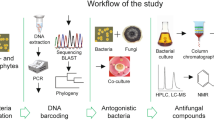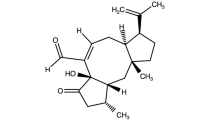Abstract
Botrytis cinerea, the causal agent of gray mold is one of the major devastating fungal pathogens that occurs in strawberry cultivation and leads to massive losses. Due to the rapid emergence of resistant strains in recent years, an ecofriendly disease management strategy needs to be developed to control this aggressive pathogen. Bacillus velezensis CE 100 exhibited strong antagonistic activity with 53.05% against B. cinerea by dual culture method. In the present study, 50% of culture filtrate supplemented into PDA medium absolutely inhibited mycelial growth of B. cinerea whereas the highest concentration (960 mg/L) of different crude extracts including ethyl acetate, chloroform, and n-butanol crude extracts of B. velezensis CE 100, strongly inhibited mycelial growth of B. cinerea with the highest inhibition of 79.26%, 70.21% and 69.59% respectively, resulting in severe damage to hyphal structures with bulging and swellings. Hence, the antifungal compound responsible was progressively separated from ethyl acetate crude extract using medium pressure liquid chromatography. The purified compound was identified as methyl hippurate by nuclear magnetic resonance and mass spectrometry. The inhibitory effect of methyl hippurate on both spore germination and mycelial growth of B. cinerea was revealed by its dose-dependent pattern. The spore germination rate was completely restricted at a concentration of 3 mg/mL of methyl hippurate whereas no mycelial growth was observed in agar medium supplemented with 4 mg/mL and 6 mg/mL of methyl hippurate by poisoned food method. Microscopic imaging revealed that the morphologies of spores were severely altered by long-time exposure to methyl hippurate at concentrations of 1 mg/mL, 2 mg/mL and 3 mg/mL and hyphae of B. cinerea were severely deformed by exposure to methyl hippurate at concentrations of 2 mg/mL, 4 mg/mL and 6 mg/mL. No significant inhibition on tomato seed germination was observed in treatments with methyl hippurate (2 mg/mL) for both 6 h and 12 h soaking period as compared to the controls. Based on these results, B. velezensis CE 100 could be considered a potential agent for development of environmentally friendly disease control strategies as a consequence of the synergetic interactions of diverse crude metabolites and methyl hippurate.



Similar content being viewed by others
References
Adnan M, Hamada MS, Hahn M, Li GQ, Luo CX (2019) Fungicide resistance of Botrytis cinerea from strawberry to procymidone and zoxamide in Hubei, China. Phytopathol Res 1(1):17
Aktar W, Sengupta D, Chowdhury A (2009) Impact of pesticides use in agriculture: their benefits and hazards. Interdiscip Toxicol 2(1):1–12
Alaoui F, Askarne L, Boubaker H, Boudyach E, Ben Aoumar A (2017) Control of gray mold disease of tomato by postharvest application of organic acids and salts. Plant Pathol J 16:62–72
Balouiri M, Sadiki M, Ibnsouda SK (2016) Methods for in vitro evaluating antimicrobial activity: a review. J Pharm Anal 6(2):71–79
Bodel PT, Cotran R, Kass EH (1959) Cranberry juice and the antibacterial action of hippuric acid. J Lab Clin Med 54(6):881–888
Choi TG, Maung CEH, Lee DR, Henery AB, Lee YS, Kim KY (2020) Role of bacterial antagonists of fungal pathogens, Bacillus thuringiensis KYC and Bacillus velezensis CE 100 in control of root-knot nematode, Meloidogyne incognita and subsequent growth promotion of tomato. Biocontrol Sci Techol 30(7):685–700
Dalié D, Deschamps A, Richard-Forget F (2010) Lactic acid bacteria–potential for control of mould growth and mycotoxins: a review. Food Control 21(4):370–380
Dean R, Van Kan JA, Pretorius ZA, Hammond-Kosack KE, Di Pietro A, Spanu PD, Rudd JJ, Dickman M, Kahmann R, Ellis J, Foster GD (2012) The Top 10 fungal pathogens in molecular plant pathology. Mol Plant Pathol 13(4):414–430
d’Enfert C (1997) Fungal spore germination: insights from the molecular genetics of Aspergillus nidulans and Neurospora crassa. Fungal Genet Biol 21(2):163–172
Devi S, Kiesewalter HT, Kovács R, Frisvad JC, Weber T, Larsen TO, Kovacs AT, Ding L (2019) Depiction of secondary metabolites and antifungal activity of Bacillus velezensis DTU001. Synth Syst Biotechnol 4(3):142–149
Droby S, Lichter A (2007) Post-harvest Botrytis infection: etiology, development and management. In: Elad Y, Williamson B, Tudzynski P, Delen N (eds) Botrytis: biology, pathology and control. Springer, Dordrecht, pp 349–367
Elad Y, Pertot I, Prado AMC, Stewart A (2016) Plant hosts of Botrytis spp: Botrytis–the fungus, the pathogen and its management in agricultural systems. Springer International Publishing, Switzerland, pp 413–486
El-Naggar NEA, El-Bindary AAA, Abdel-Mogib M, Nour NS (2017) In vitro activity, extraction, separation and structure elucidation of antibiotic produced by Streptomyces anulatus NEAE-94 active against multidrug-resistant Staphylococcus aureus. Biotechnol Biotechnol Equip 31(2):418–430
Gajbhiye MH, Kapadnis BP (2016) Antifungal-activity-producing lactic acid bacteria as biocontrol agents in plants. Biocontrol Sci Technol 26(11):1451–1470
Gerez C, Carbajo M, Rollán G, Torres Leal G, Font de Valdez G (2010) Inhibition of citrus fungal pathogens by using lactic acid bacteria. J Food Sci 75(6):M354–M359
Gu Q, Yang Y, Yuan Q, Shi G, Wu L, Lou Z, Huo R, Wu H, Borriss R, Gao X (2017) Bacillomycin D produced by Bacillus amyloliquefaciens is involved in the antagonistic interaction with the plant-pathogenic fungus Fusarium graminearum. Appl Environ Microbiol 83(19):e01075-e1117
Hartman J, Kaiser C (2008) Strawberry fruit rots. University of Kentucky : UK Cooperative Extension Service. No. PPFS-FR-S-08
Huang R, Li GQ, Zhang J, Yang L, Che HJ, Jiang DH, Huang HC (2011) Control of postharvest Botrytis fruit rot of strawberry by volatile organic compounds of Candida intermedia. Phytopathology 101(7):859–869
Hussein Al Ali SH, Al-Qubaisi M, El Zowalaty M, Hussein MZ, Ismail M (2013) Antimicrobial activity of hippurate nanocomposite and its cytotoxicity effect in combination with cytarabine against HL-60. J Nanomater. https://doi.org/10.1155/2013/843647
Jeong MH, Lee YS, Cho JY, Ahn YS, Moon JH, Hyun HN, Cha GS, Kim KY (2017) Isolation and characterization of metabolites from Bacillus licheniformis MH48 with antifungal activity against plant pathogens. Microb Pathog 110:645–653
Kaur T, Kaur A, Sharma V, Manhas RK (2016) Purification and characterization of a new antifungal compound 10-(2,2-dimethyl-cyclohexyl)-6-9-dihydroxy-4-9-dimethyl-dec-2-enoic acid methyl ester from Streptomyces hydrogenans strain DH16. Front Microbiol 7:1004
Lees HJ, Swann JR, Wilson ID, Nicholson JK, Holmes E (2013) Hippurate: the natural history of a mammalian–microbial cometabolite. J Proteome Res 12(4):1527–1546
Li X, Zhang Y, Wei Z, Guan Z, Cai Y, Liao X (2016) Antifungal activity of isolated Bacillus amyloliquefaciens SYBC H47 for the biocontrol of peach gummosis. PLoS ONE 11(9):e0162125
Liu S, Che Z, Chen G (2016) Multiple-fungicide resistance to carbendazim, diethofencarb, procymidone, and pyrimethanil in field isolates of Botrytis cinerea from tomato in Henan Province, China. Crop Prot 84:56–61
Lord RS, Bralley JA (2008) Clinical applications of urinary organic acids. Part I: detoxification markers. Altern Med Rev 13(3):205–215
Mares JH, Gramacho KP, Santos EC, da Silva SA, Santana JO, de Sousa AO, Alvim FC, Pirovani CP (2017) Proteomic analysis during of spore germination of Moniliophthora perniciosa, the causal agent of witches’ broom disease in cacao. BMC Microbiol 17(1):1–10
Maung CEH, Baek WS, Choi TG, Kim KY (2021) Control of grey mould disease on strawberry using the effective agent, Bacillus amyloliquefaciens Y1. Biocontrol Sci Technol. https://doi.org/10.1080/09583157.2020.1867707
Mekawi EM, Khafagi EY, Abdel-Rahman FA (2019) Effect of pre-harvest application with some organic acids and plant oils on antioxidant properties and resistance to Botrytis cinerea in pepper fruits. Sci Hortic 257:108736
Morgunov IG, Kamzolova SV, Dedyukhina EG, Chistyakova TI, Lunina JN, Mironov AA, Stepanova NN, Shemshura ON, Vainshtein MB (2017) Application of organic acids for plant protection against phytopathogens. Appl Microbiol Biotechnol 101(3):921–932
Ongena M, Jacques P (2008) Bacillus lipopeptides: versatile weapons for plant disease biocontrol. Trends Microbiol 16(3):115–125
Pan J, Devarie-Baez NO, Xian M (2011) Facile amide formation via S-nitrosothioacids. Org Lett 13(5):1092–1094
Peng M, Patel P, Nagarajan V, Bernhardt C, Carrion M, Biswas D (2019) Feasible options to control colonization of enteric pathogens with designed synbiotics. In: Watson R, Preedy V (eds) Dietary interventions in gastrointestinal diseases. Elsevier, Amsterdam, pp 135–149
Petrasch S, Knapp SJ, Van Kan JA, Blanco-Ulate B (2019) Grey mould of strawberry, a devastating disease caused by the ubiquitous necrotrophic fungal pathogen Botrytis cinerea. Mol Plant Pathol 20(6):877–892
Plumridge A, Hesse SJA, Watson AJ, Lowe KC, Stratford M (2004) The weak acid preservative sorbic acid inhibits conidial germination and mycelial growth of Aspergillus niger through intracellular acidification. Appl Environ Microbiol 70(6):3506–3511
Regassa AB, Cho JY, Kim KY (2020) Identification and characterization of methyl succinate from Bacillus velezensis AR1. Australas Plant Pathol 49:357–365
Rupp S, Weber RW, Rieger D, Detzel P, Hahn M (2017) Spread of Botrytis cinerea strains with multiple fungicide resistance in German horticulture. Front Microbiol 7:2075
Saito S, Michailides T, Xiao C (2016) Fungicide resistance profiling in Botrytis cinerea populations from blueberry in California and Washington and their impact on control of gray mold. Plant Dis 100(10):2087–2093
Seepe HA, Lodama KE, Sutherland R, Nxumalo W, Amoo SO (2020) In vivo antifungal activity of South African medicinal plant extracts against Fusarium Pathogens and their phytotoxicity evaluation. Plants 9(12):1668
Shafi J, Tian H, Ji M (2017) Bacillus species as versatile weapons for plant pathogens: a review. Biotechnol Biotechnol Equip 31(3):446–459
Tomas-Grau R, Hael-Conrad V, Requena-Serra F, Perato SM, Caro MdP, Salazar SM, Díaz-Ricci JC (2020) Biological control of strawberry grey mold disease caused by Botrytis cinerea mediated by Colletotrichum acutatum extracts. Biocontrol. https://doi.org/10.1007/s10526-020-10003-4
Toral L, Rodríguez M, Béjar V, Sampedro I (2018) Antifungal activity of lipopeptides from Bacillus XT1 CECT 8661 against Botrytis cinerea. Front Microbiol 9:1315
Williamson B, Tudzynski B, Tudzynski P, Van Kan JA (2007) Botrytis cinerea: the cause of grey mould disease. Mol Plant Pathol 8(5):561–580
Wu L, Wu H, Chen L, Yu X, Borriss R, Gao X (2015) Difficidin and bacilysin from Bacillus amyloliquefaciens FZB42 have antibacterial activity against Xanthomonas oryzae rice pathogens. Sci Rep 5:12975
Yuan J, Li B, Zhang N, Waseem R, Shen Q, Huang Q (2012) Production of bacillomycin-and macrolactin-type antibiotics by Bacillus amyloliquefaciens NJN-6 for suppressing soilborne plant pathogens. J Agric Food Chem 60(12):2976–2981
Acknowledgements
This research was financially supported by Chonnam National University (Grant Number: 2018-3347).
Author information
Authors and Affiliations
Corresponding author
Ethics declarations
Conflict of interest
The authors declared that there is no conflict of interest.
Additional information
Publisher's Note
Springer Nature remains neutral with regard to jurisdictional claims in published maps and institutional affiliations.
Supplementary Information
Below is the link to the electronic supplementary material.
Rights and permissions
About this article
Cite this article
Maung, C.E.H., Lee, H.G., Cho, JY. et al. Antifungal compound, methyl hippurate from Bacillus velezensis CE 100 and its inhibitory effect on growth of Botrytis cinerea. World J Microbiol Biotechnol 37, 159 (2021). https://doi.org/10.1007/s11274-021-03046-x
Received:
Accepted:
Published:
DOI: https://doi.org/10.1007/s11274-021-03046-x




